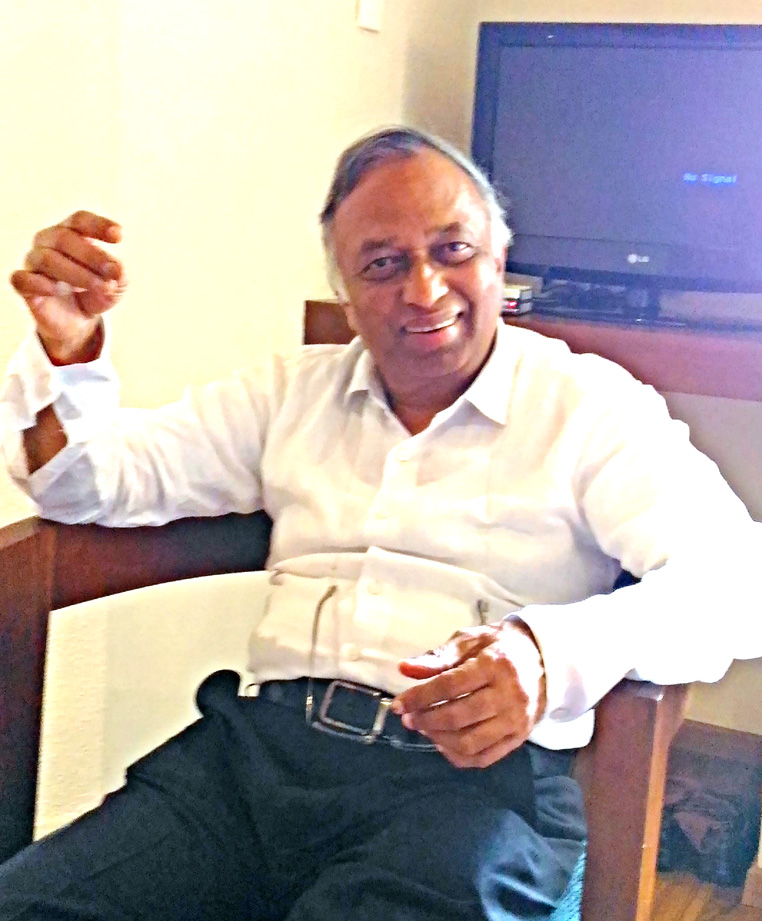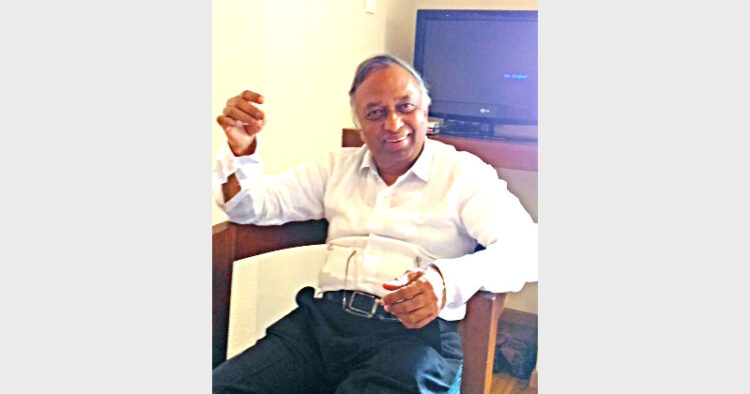 The person who stood by and advocated the integration of knowledge and learning from the ancient Indian scientific wisdom is now the Chancellor of Nalanda University. Under his able leadership and guidance, Vijnana Bharati organised a four days convention on confluence of modern and traditional sciences.
The person who stood by and advocated the integration of knowledge and learning from the ancient Indian scientific wisdom is now the Chancellor of Nalanda University. Under his able leadership and guidance, Vijnana Bharati organised a four days convention on confluence of modern and traditional sciences.
Dr Vijay Bhatkar is a scientist of different kind who takes inspiration from spirituality and Bhakti Movement for his computer science. He spoke to Prafulla Ketkar, Editor Organiser and Ganesh Krishnan R, Sub-Editor about his journey and idea behind the confluence of knowledge systems. Excerpts:
First of all, hearty congratulations for this new responsibility as the Chancellor of Nalanda University. It is in a way in tune with your life, vision and journey. How do you look at this journey from a computer scientist to the Chancellor of Nalanda?
It is awesome. I remember the turning point as I saw in the year 1996 while celebrating the 700th anniversary of Dnyaneswar’s Samadhi. We had completed the development of PARAM 8000, our super computer. We had a team which was working day and night for the next model, PARAM 10000, which means a trillion mathematical operations per second. No holidays. There is a famous Moore”s Law in computing which says that the number of transistors per square inch on integrated circuits had doubled every year since their invention. So this trend continues, everything what is being invented becomes zero in no time. While thinking about the 700 years old commentary on Bhagavad Gita enunciated by Sant Dnyaneshwar, which is still profoundly beautiful and relevant, I realised that we are in the delusion that we are doing something great. If you go back to Bhagavad Gita which was written 5000 years back, or the Vedas which were written much earlier, you cannot change anything either the utterance or what was written. Then another thought occurred to me was that what Vedas are trying to proclaim. Ved Vakyas, Sutras, etc. are the equations of eternity. Aham Brahmasmi or Tatvamasi or Pragyanam Brahma or Ayam Atma Brahma are the expressions of reality. Science also tries to do that. Science finds only the quintessence of reality of nature. So this was a really awakening moment for me.
How would you describe the Indian knowledge
system?
The Indian knowledge system or Vedic knowledge system (Vedangas, Darshanas, Brahmasutra, Itihasas, Puranas, complemented by Buddhist and Jain Darshanas) constitutes a grand system of profound knowledge system of India.The corollary to this is the idea of Vigyan and Dharma, Science and Spirituality. We are not saying that science alone is the knowledge. Then I understood from Bhagavad Gita, the 7th adhyaya. No one has given such a definition to knowledge. There are many definitions of science. What Dnyaneshwara says is Vigyan is Prapancha, secular or material knowledge coming from Pancha mahabhutas. Everything we study today whether it is political science, biology or natyashastra all are human endeavours. They are in a way integrated and not compartmentalised. Whereas, the spirituality is the knowledge of ‘self’. Who is having Brahma Jijnyasa? Me. You want to understand the outside world but you don’t want to know who am ‘I’? This whole process of knowing my journey into my inner universe is spirituality. These two altogether constitute the full knowledge. The whole idea of confluence of science emanates from that.
But many modernists say that unless you empirically prove something it cannot be considered as a science.
Interestingly, if you look at our knowledge system, the valid knowledge comes with six Pramanas (proofs or means of knowledge). The so-called modern Sciences so far dominantly use only two pramanas, that is Pratyaksh (direct perception) and Anuman (inference). Upam?a (comparison and analogy), Arth?patti (postulation, derivation from circumstances), Anupalabdi (non-perception, negative/cognitive proof) and ?abda (word, testimony of past or present reliable experts) are not considered as proofs in modern sciences and therefore, this problem occurs. In our knowledge system , Parampara (tradition) is also considered as a proof, as it comes from wisdom. You can question it like sciences but all of us believe in Parampara.
Newton gave the new world view, i.e. the mechanical world view which was correct at that time. Einstein admits the space-time continuum, the Theory of Relativity, a different world view, then comes Quantum Mechanics. Now consciousness, studies which takes us to the Vedic views that the reality is nothing but a triad of myself (the observer), object (the observed) and the observation (state of consciousness). That is why I believe that this confluence is possible.
So in this backdrop, how do you see your role in Nalanda?
I have always talked about Nalanda and Takshila and our ancient universities. When India was considered as a great civilisation world over, Princess and sages from all over the world came to Nalanda, right from Japan to Tibet, China, Korea, Mongolia, Laos, Cambodia, Indonesia and even Turkey. Many people in the East Asia Summit admitted that their nations were shaped by Nalanda. When the idea of Nalanda was mooted in Bankok, 22 nations supported the idea, which was originally proposed by Dr APJ Abdul Kalam. I share that dream. We will be truly a developed country on Indian parameters when students from all over the world will come to India to seek knowledge. Can we recreate that kind of knowledge system? This is the real challenge. We will have to learn from ancient wisdom, connect with modern technology as we did in Management Sciences (Bhagavad Gita and Management), nurture great acharyas with same zeal and wisdom who can visualise and design new pedagogy and deliver it effectively.
This is an evolutionary process. We have made the beginning. We have started with three schools, first one is Buddhist, religion and comparative studies, secondly the school of historical studies and thirdly the school of environment and ecology. But ultimately for this whole endeavour, acharyas will have to come from the same system which thrives on dichotomies and separation of knowledge. We need to train the people who believe in strong spiritual foundation of integrated knowledge and we are working in that direction.
Did you see this possibility of traditional knowledge system and modern sciences coming together in the near future? Is Bharatiya Vigyan Sammelan is a step in this direction?
It will create a new path. All technological developments are meant for happiness. We have understood everything, population, individuals, societies and respective material needs. But we have not understood the meaning of happiness. Wellness, happiness, well being, these questions are arising even in the Western world particularly because of the realisation that the manifestation of reality is much beyond what we see. Now many people are started studying Ayurgenomics which is combination of Ayurveda and Genetics. This process will certainly show us a new light. Unfortunately, it is not happening with enough speed in India, that is my concern. Bharatiya Vigyan Sammelan is an effort to popularise this trend with the participation of common people and make this trend as a movement.
Will you suggest some steps for academicians and young researchers, that they can follow to converge on two pearls of wisdom?
Why not? Today Ayurveda people study modern medicine. Why can’t Allopathic practitioners learn Ayurveda? What we need is the exposure. The Ayurveda people must have exposure of modern anatomy, physiology and there should be teachers who have studied both. This is the new knowledge system India can create. I am not limiting to the national boundaries. This is the new way of looking at things. There are profound disciplines. On cancer cure billions and billions of dollars are spent overseas. If we can provide Ayurveda & cow therapy as an alternative, why not? People will come to us. This is going to happen in the future. Our educationist and students need to believe this, for that they should get the exposure to this confluence of knowledge.










![A Representative image [ANI Photo]](https://organiser.org/wp-content/uploads/2025/12/representative-image-e1765612818961-120x70.webp)


Comments